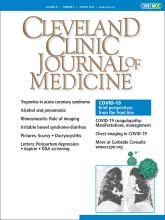No. Once the cardiac troponin concentration is higher than the 99th per centile (the upper reference limit), finding the peak value (before levels start to descend) does not help diagnose the cause of the elevation. Although the peak level has prognostic significance, continuing to follow the level after the initial set of measurements adds cost to the evaluation without providing further insight into cause, and any prognostic information gained would not change the subsequent evaluation or management, which should be driven by guidelines.1
See related editorial, page 483
DEFINITIONS
Standard practice in evaluating for possible acute coronary syndrome includes following serial cardiac troponin levels.
The Fourth Universal Definition of Acute Myocardial Infarction calls cardiac troponin levels above the 99th percentile myocardial injury, which is considered acute if the level rises or falls (or both).2 Acute myocardial infarction requires acute myocardial injury plus signs or symptoms of acute myocardial ischemia or other findings. There are 5 types of myocardial infarction; here, we are mainly concerned with type 1 (caused by acute coronary occlusion) and type 2 (caused by an acute imbalance of oxygen supply and demand).
DISTINGUISHING THE CAUSE OF TROPONIN ELEVATION
In the workup of acute coronary syndrome, cardiac troponin levels may be elevated, but keep in mind that they can be elevated in many conditions other than type 1 myocardial infarction.
Type 1 vs type 2 myocardial infarction
Distinguishing type 1 from type 2 acute myocardial infarction is important but challenging. No clinical criteria exist to reliably tell them apart,3 and unfortunately, cardiac troponin levels (whether initial, peak, or the trend over time) cannot help to do so either.4 The delta value (ie, the change in cardiac troponin level in a defined time period) has been studied for this purpose; although the absolute change is more reflective of the different types of myocardial infarction than the percent change, neither can reliably distinguish between them.4,5
Other causes of troponin elevation
Cardiac troponin levels can be elevated in other conditions that commonly arise in medically complex patients, eg, sepsis, acute stroke, respiratory failure, hypertensive crisis, or with some chemotherapy regimens.6 In some diseases, such as heart failure and chronic kidney disease, levels may be persistently elevated. Hence, trying to find a peak value in a patient with persistently elevated levels may be futile and is an inappropriate use of this biomarker.
DOES TROPONIN PREDICT ADVERSE EVENTS?
The degree of cardiac troponin elevation in myocardial infarction can indicate the extent of myocardial damage and help predict adverse events.7,8 Treatment decisions, however, should not be based on degree of elevation alone. Rather, patients should be managed with guideline-directed medical therapies, procedures, and education,1 regardless of the degree of troponin elevation.
All patients who are diagnosed with acute coronary syndrome with elevated cardiac troponin should undergo echocardiography, which provides prognostic information similar to that of the peak troponin value, obviating the need to follow troponin levels until they peak.9
After acute coronary syndrome is diagnosed, and especially if confirmed with angiography, further troponin testing may confuse the clinical picture. Studies have found that although cardiac troponin levels rise after angiography or percutaneous coronary intervention, the increase is not associated with adverse events.10
IF SYMPTOMS RECUR
Cardiac troponin levels are often elevated in hospitalized patients experiencing recurrent symptoms after a myocardial infarction.11 In this situation, the patient should be managed on the basis of ischemic symptoms, echocardiographic changes, and hemodynamic status rather than on the elevated troponin alone. Troponin rises with reinfarction, but for the initial evaluation, monitoring levels to a peak will not lead to differences in management, rendering it unnecessary in this context.
TESTING INCREASES COSTS
Chest pain is one of the most common presentations in the emergency department, and costs run high for its evaluation.12 After the first set of cardiac troponin levels has been obtained, additional measurements (including prolonged monitoring until a peak occurs) do not add useful or reliable information to the workup or change the treatment plan. Excessive troponin testing also leads to unnecessary cost, increased length of stay, and further blood draws.13
Addressing the issue of inappropriate troponin monitoring will help reduce unnecessary resource utilization at both the individual provider and systems levels. Love et al,14 in a study analyzing electronic medical record requests over 2 months, found that providers overrode a best practice alert (that recommended not conducting unwarranted cardiac troponin testing) 97% of the time. Further education and collaboration between emergency medicine and laboratory medicine physicians and clinical chemists is recommended to help limit overuse and misinterpretation of cardiac troponin testing.15
NEW TESTS DO NOT CHANGE THE MESSAGE
New troponin assays are becoming more sensitive; in practice this means that elevated values will likely be detected much sooner. Although these assays are sometimes called “high-sensitivity,” their characteristics vary, and what high sensitivity means is not clearly defined in current guidelines.
The potential for overtesting remains if providers continue to follow cardiac troponin levels after the rising or falling pattern has become apparent, particularly when a diagnosis has already been made.
Footnotes
Dr. Apple has disclosed membership on advisory committees, review panels, or board of directors for Brava Diagnostics, HyTest, Instrumentation Laboratory, and Siemens.
- Copyright © 2020 The Cleveland Clinic Foundation. All Rights Reserved.






